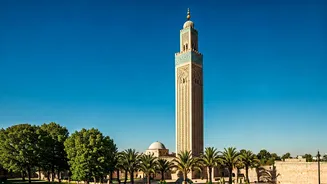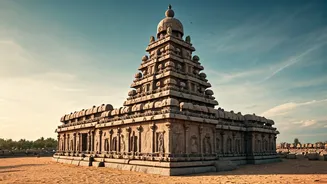Delhi's Qutub Minar
The Qutub Minar, standing tall in Delhi, is a UNESCO World Heritage site and a prime example of Indo-Islamic architecture. Construction began in 1199 by
Qutb al-Din Aibak and was later continued by his successors. This towering structure, made of red sandstone and marble, features five distinct stories, each marked by intricate carvings and inscriptions from the Quran. The minar's purpose was multi-faceted, serving as a victory tower and a minaret for the adjacent Quwwat-ul-Islam Mosque. Its height and design reflect a blend of Persian and Indian architectural styles, offering visitors a glimpse into the artistic exchange that took place during the Delhi Sultanate. The Qutub Minar remains a symbol of Delhi's rich cultural heritage, attracting tourists and history enthusiasts alike to appreciate its grandeur and historical value. Its presence in Delhi showcases the city's rich past and its contributions to the world of architecture and art.
Alai Minar's Legacy
The Alai Minar, also situated in Delhi, represents the ambitious architectural endeavors of Alauddin Khilji. This structure was intended to be twice the height of the Qutub Minar, reflecting the sultan's aspirations. Although construction began in the early 14th century, it was never completed. Only the first story of the minar was finished, providing a unique glimpse into the planned scale and design. The Alai Minar's unfinished state provides insights into the challenges and ambitions of the Delhi Sultanate's rulers. The partially constructed minar showcases intricate detailing and design principles similar to the Qutub Minar, giving visitors an understanding of the architectural plans and the rich architectural heritage of the time. This monument is a testament to the grand vision and architectural styles prevalent during the Khilji dynasty, offering a captivating study into the past.
Chittorgarh's Victory Tower
The Victory Tower, or Vijay Stambh, in Chittorgarh, Rajasthan, is a remarkable structure that celebrates the Rajput triumph over the combined armies of Gujarat and Malwa. Built by Maharana Kumbha in the 15th century, the tower rises approximately 37 meters and features nine stories. It is covered in detailed carvings that depict Hindu deities, scenes from epics, and inscriptions. This historical site stands as a symbol of valor and victory, providing detailed insights into the Rajput architectural styles. Climbing to the top offers panoramic views of the fort and surrounding landscape, adding to its appeal. Each level has unique features, including balconies and intricate detailing. The Victory Tower is not only a symbol of military success but also a testament to the Rajput rulers' artistic and cultural patronage.
Charminar: Hyderabad's Jewel
The Charminar, in Hyderabad, is a globally recognized monument and a symbol of the city's identity. Constructed in 1591 by Muhammad Quli Qutb Shah, this structure features four towering minarets, each standing approximately 48.7 meters high. The Charminar was built to celebrate the end of a deadly plague and also served as the heart of the city's development. The monument's architecture blends Persian, Islamic, and Hindu influences, showcasing Hyderabad's multi-cultural heritage. The monument includes intricate arches, stucco decorations, and the use of granite and limestone. The Charminar remains a busy center of activity, surrounded by bustling markets and streets. It remains an enduring symbol of Hyderabad, attracting visitors from all over the world and symbolizing the city's cultural diversity.
Fateh Burj: Punjab's Triumph
Fateh Burj, located in Chappar Chiri, Punjab, commemorates the victory of the Sikh warrior Banda Singh Bahadur over the Mughal army in 1710. This impressive tower stands as the tallest minar in India, reaching a height of around 328 feet (100 meters). Its design incorporates distinct architectural styles, and it serves as a proud reminder of the historical significance of the victory. The Fateh Burj is more than a monument; it is a symbol of Sikh valor and resilience. The design details and structure of the Fateh Burj showcase the victory and commemorate the key events associated with Banda Singh Bahadur's triumph. The construction of the Fateh Burj shows the valorous history and strength of the Sikh community.
Minar-E-Pakistan's Glory
Minar-e-Pakistan, located in Lahore, is a national monument that commemorates the Lahore Resolution, which was a landmark event that led to the creation of Pakistan. The construction was completed in 1968, and the minar stands tall as a symbol of the nation's independence and identity. This minaret has a unique architectural design and is made of concrete and marble. Its height and design symbolize the aspirations and struggles of the Pakistani people. The base is inscribed with important national documents and speeches, offering visitors a deeper understanding of Pakistan's history. Minar-e-Pakistan remains a key symbol and historical landmark. The monument represents the unity and the legacy of Pakistan.















